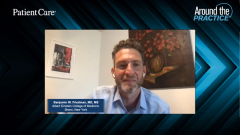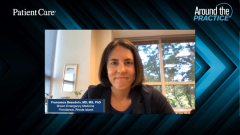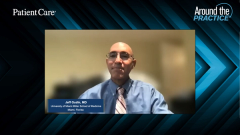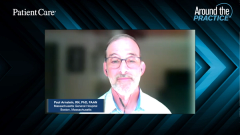
Pathogenesis and Causes of Acute Pain
Pain experts discuss the pathogenesis and factors leading to acute pain.
Episodes in this series

Benjamin W. Friedman, MD, MS: Let’s briefly discuss the pathogenesis of acute pain. What pathways are involved in sensations of pain? How does acute pain occur? Jeff, can I turn to you for that?
Jeff Gudin, MD: Sure. This is right up my alley. We have very specialized receptors under the skin called nociceptors, which are responsible for picking up the initial sensation of pain. I used to think that pain was simply an electrical message. When you hit your funny bone, you get a jolt of electricity up to the spinal cord and then it goes up to the brain. But it isn’t just neural, it’s also a biochemical phenomenon. When we have acute tissue damage, such as a fracture or laceration, there are neurochemical reactions at the site of injury that activate the free endings, the specialized receptors called nociceptors. That initiates a nerve impulse that propagates throughout the entire nervous system.
In the pain world, we think about the transmission of that impulse to best decide how we could treat this. Is there a way to treat this at the skin with a local anesthetic or a TENS [transcutaneous electrical nerve stimulation] machine? Is there a way to treat this along the peripheral nerve, maybe with a local anesthetic injection? How do we treat the impulses at the spinal cord with more centrally acting agents? Even then, after it synapses in the spinal cord and goes to higher-order neurons in the cerebral centers, what medicines or techniques can we use to modulate the pain at the brain? I say techniques, because as we’ll talk about it in a few minutes, that mind-body connection in pain is sometimes just as important as any chemical-mind interaction. Both pharmacological therapies and nonpharmacological therapies can modulate pain.
The process of nociception is a complex one. But if you think about it systematically, it starts at the skin, travels along a nerve, synapses in the spinal cord, and goes to the higher-order neurons up in the brain. That’s the afferent, or the ascending loop. Then we have a descending loop, which is also modulatory. It’s inhibitory. There are various chemicals that work on the inhibitory pathways as well. We need to know a little about the pathophysiology of pain when we think about how to best treat it.
Francesca Beaudoin, MD, MS, PhD: Jeff, that’s such a great description of pain and pain processing. I totally agree with you. You hit the nail on the head that we need to be thinking about mechanism-based pain management, not just on the underlying condition that we’re treating. We need to think about those pathways, the various targets, and the next level of both pharmacotherapies and nonpharmacologic treatments for acute pain management. That transition from acute to chronic pain is also important. Great description.
Jeff Gudin, MD: Thanks.
Benjamin W. Friedman, MD, MS: Jeff mentioned this a little, but Francesca, could you talk a little more about other factors that lead to the intensity and sensations of acute pain? I’m specifically thinking about psychological and social phenomena that might contribute to a patient’s sensations of pain.
Francesca Beaudoin, MD, MS, PhD: As Jeff mentioned, we know that pain is complex. We talk in the pain world about the biopsychosocial model of pain and how pain starts, so we know that it’s more than just that initial tissue injury or inflammation or whatever the inciting event is. More than that, there are pretraumatic risk factors: factors about the person, their environment, and the things that they bring to the table at the time of injury. Most of the time, those things are difficult to modify.
I prefer trauma and surgery as models for pain because we know exactly when it happened, and we can often characterize the events of the trauma or we know factors about the surgery, and then we can follow it over time. There are things about the event itself that contribute to acute pain. Some of those things include whether the trauma was stressful. Did someone think that their life was in jeopardy? Take a car accident, for instance. We know that if somebody perceived that they almost died in a car accident, even if it was objectively a minor fender bender with minimal damage to the car and they were going only 10 miles per hour, their likelihood of having acute pain at the time of that event is much higher. And their likelihood of developing persistent or chronic pain following that event is also much higher than somebody who didn’t think their life was in jeopardy.
Clearly, there’s this component of emotional and psychological stress at the time of the event, and that falls in line with surgery and other types of pain as well. What can we do about that? How can we modify that? Because that’s modifiable. Somebody’s sociodemographics before the event aren’t modifiable. We can’t do anything about that. But how do we deal with that acute response? How can we intervene in both the emergency department and primary care offices? What tools can we equip people with to better respond to pain and improve their trajectory and outcomes?
Paul Arnstein, RN, PhD, FAAN: I’d like to dovetail on that, because motor vehicle accidents are a good example. No matter how minor or severe the motor vehicle accident is, a person’s way of perceiving or the meaning of the situation drives the pain levels up or down. For example, when people are catastrophizers and think, “Oh my God, this is awful. This is terrible. It’s the worst thing that can happen. My wife is going to divorce me. I’m going to lose my job,” that can lead to some of the anxiety, depression, and the meaning of the pain that drives pain levels up.
That’s in contrast to some of the self-efficacy beliefs, such as, “I’m in good hands. I’ve survived this. I’m going to get back. It might take some time.” Having that realistically optimistic appraisal of the situation is one of the important things that we see clinically with people, where we have an opportunity to intervene and help control some of the things that can escalate pain out of control and cause it to persist in terms of interfering with their healing and recovery with pain and coping.
Transcript Edited for Clarity
Newsletter
Enhance your clinical practice with the Patient Care newsletter, offering the latest evidence-based guidelines, diagnostic insights, and treatment strategies for primary care physicians.























































































































































































































































































